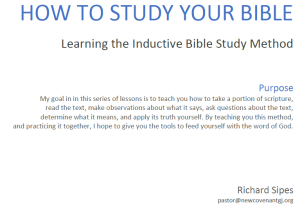How to Study Your Bible, Part 2
If you haven’t read Part1, you missed the Introduction and Bible Study Step #1: Prayerfully Read the Text in Context. Then go to Part 3.
Click to: Download the PDF handout
Bible Study Step #2 – Observe the Text in Detail.
The way we read and study the Bible flows from what the Bible is. The Bible declares about itself that all scripture is inspired by God (2 Tim. 3:16), that it is our spiritual food (Matt. 4:4), that it gives life (John 6:63), that it makes us wise for salvation through faith in Christ (2 Tim. 3:15), and that it is profitable for doctrine, for reproof, for correction, and for instruction in righteousness (2 Tim. 3:17). If we believe that, then we will want to get the most out of it. Every portion of Scripture is important—even the smallest letter and stroke of a letter (Matt. 5:18). The details matter. If we’re going to develop Bible observation skills, we must believe that “all Scripture is God-breathed,” that we are called to live by “every word” of God, and that even the smallest letter and least stroke of the pen will never pass away.
Reading the text over and over will help us to observe what it says. When we know what it says, then we can better determine what it means and how to apply it. As you get familiar with the text, you will begin to notice things about it that will help you understand what it says.

A. Look for what is obvious.
Start simply at the beginning. Read through the passage you are studying, looking for what is obvious. On your first time through, don’t be distracted by things that are unclear. You will take time to investigate them later. For now, focus on the obvious. Most scripture is clear and understandable. Resist the temptation to immediately look at the notes in your study Bible or at a commentary. You don’t want to spoil the priceless joy of discovering Biblical truth for yourself.
What is obvious to you from your reading of Psalm 119;1-8?
There are several levels or layers we might observe in a text. The first is the context, which has several layers itself (Historical or cultural context; whole Bible; OT or NT; Book; Chapter; Paragraph). The verses of the passage itself are made of paragraphs or stanzas, sentences, phrases, words, and grammar.
One way to begin observation is to …
B. Look for Key Words or Phrases.
Key words or phrases are essential to the flow and meaning of the passage. They cannot be removed from the text without making the passage meaningless. If we tried to remove these key words, the passage would make no sense. Key words or phrases will often answer one or more of the 5 Ws or H questions. Who is speaking, acting, or central to the passage? What is the passage about? When does it take place? Where is it happening? How does it communicate its truth?
Read Psalm 119:1-8 again. This time, look for key words or phrases that point to the subject or theme of the section. What is this text about?
Questions to draw out key words and phrases:
Is there a purpose statement given?
Is there something unexpected?
Is there something emphasized?
Is there a command?
Is there a warning?
Are words or phrases repeated?
Are roles or actions of God mentioned?
Does the passage quote other scriptures?
God, Jesus Christ, and the Holy Spirit are obviously always key in the scriptures wherever they appear. The whole Bible is about God.
Where do we find God in Psalm 119:1-8?
In Psalm 119:1, He is called LORD (YHVH, the covenant name of God) in relation to His law. In Psalm 119:2,3 we see God in “His testimonies” and “His ways”, as well as being “Him” we seek.
In Psalm 119:4-8, the psalmist addresses God directly (as in a prayer) with the second person masculine singular pronoun (You). The psalmist sees God as the one who commanded (4,6), whose precepts and statutes are to be kept (5,8), who should be praised (7), and who has righteous judgments (8).
We can sometimes identify key words or phrases by the fact that they are often repeated. A good way to remember the key words is to mark them by underlining or highlighting them. If you don’t like to mark your Bible you can print a copy of the passage and mark that, or you can simply take notes elsewhere. Someone said, “It’s good to mark your Bible, but it is better to let your Bible mark you.” Remember our goal is not just to understand, but to obey God’s word and to be sanctified by it.
What words are repeated in Psalm 119?
Blessed (twice, Ps. 119:1, 2); walk (twice, Ps. 119:1,3); keep (three times, Ps. 119:4,5,8); statutes (twice, Ps. 119:5,8); heart (twice, Ps. 119:2,7)
Be alert to the fact that, especially in poetry, the author may use synonymous words or phrases to add variety and depth to the passage. A synonym is a word that has a similar meaning to another word. Synonyms can be subtle and more difficult to identify, especially in the initial reading of a passage. The more carefully you read the passage, the more obvious the subtle synonyms will become.
What words are used repeatedly as synonyms in the text?
The psalmist uses several words to describe the Word of God:
Law (v.1) –Torah – “law, direction, instruction.” It depicts God’s special revelation as a gracious gift.
Testimonies (v.2) – `edah – “testimony, witness.” The law of God is His testimony, because it is His own affirmation concerning His nature, attributes, and consequent demands.
Ways (v.3) – Derek – way, road, distance, journey, manner, direction, course. Refers to God’s covenant requirements.
Precepts (v.4) – Piqquwd – a fixed or appointed law; oral or written declarations as to what God expects of man.
Statutes (v.5, 8) – Choq – something prescribed or engraved, that which is ordained, decreed, or enacted.
Commandments (v.6) – Mitsvah – from a root meaning to command or charge; it emphasizes the right to give orders.
Judgments (v.7) – Mishpat – comes from a word meaning to to judge, govern, vindicate, punish.
All these words are synonyms of the “law of the Lord”, expressing the idea of God’s word in the scriptures. Seeing this, makes it clear that a key concept in Psalm 119:1-8 centers around God’s word. All these terms express the idea of the authority of God and His word. The sum effect of these terms (and other synonyms in Psalm 119) is that the Scriptures reflect the righteous character of God and speak with God’s authority.
Ask the 5 Ws and H about these key words.
When you have spotted the key words and phrases, take time to ask questions about these key words (the 5 Ws and H).
Who is saying it?
Who does it relate to?
What does the word mean?
Why is it used here?
Where else is this word used?
When does it apply?
How does it impact the flow of thought?
Knowing the context, prayerfully reading the text, and discovering the key words and phrases will often lead you to spot the main subject or theme of the passage. This is what we will look for next.
C. Seek the Subject or Theme of the passage.
The theme of a passage is the unifying idea that is developed in the passage. The theme is related to the author’s purpose for writing this portion of scripture. Try to get a sense of what the author is communicating. Ask: “What is the biblical writer talking about?” This is the subject of the passage. If you think you know, write it down. Then ask, “What is the biblical writer saying about the subject?” This is the theme. If you’re not sure yet of the theme of the passage, do more observation.
Some questions that might help at this point are:
What does the passage say about God?
What does it say about the human condition?
What does it say about God’s people?
Is there a command, example, warning, or promise in this passage?
Is the passage descriptive or prescriptive?
(prescriptive—tells you what to do, a command;
descriptive—tells what someone else did, narrative/story)Is there a change from before and after the event?
Is there a logical order or progression in the passage?
Does the passage compare or contrast things, people, or ideas?
Does the passage illustrate or explain something?
Is there a cause and effect?
Is there dialogue? If so, who is speaking? To whom?
Are there questions asked? Answers given?
What is the result or conclusion of the passage?
Having read through Psalm 119:1-8 a number of times now, I think we can easily determine the subject and theme of these verses.
What is the subject of Psalm 119:1-8?
We can conclude that the subject of Psalm 119:1-8 centers around the law of the Lord, His authoritative word.
If you had to put the theme into one sentence what would you say?
It is about the blessedness of having a heart devoted to learning and obeying the law of the LORD.
Or, God blesses those who live by His word.
Or, Living according to God’s word leads to a blessed and blameless life.
Or, obedience to God’s word is the pathway to blessing.
Write the theme in your own words.
So by simply reading, observing, and interrogating the text, we have arrived at the subject and theme of the passage.
D. Examine the Grammar.
All speaking and writing is based on words. The way those words are put together into sentences, paragraphs, chapters, and books is grammar. All languages use rules of grammar to communicate. Grammar is concerned with such things as the subject and verb of a sentence; the tense of the verbs; the characteristics of nouns and pronouns; the use of adjectives and adverbs; dependent and independent clauses; prepositions; and conjunctions or other connective words.
Questions you might ask about the grammar are:
Who is the subject of the sentence?
What is the main verb?
What is the tense, aspect, and mood of the verb?
Is there a direct object? Indirect object?
What do prepositions indicate?
Is the clause independent or dependent?
What do the adjectives and adverbs modify?
How could I diagram this sentence?
Are there pronouns and who do they refer to?
Are there figures of speech? Exaggerations or hyperboles?
Are there conjunctions? What do they do?
Are the articles definite (the) or indefinite (a)? What does this show?
Again, we want to observe the text and ask questions related to its grammar.
Read the Psalm 119:1-8 again. This time, notice the verbs (the action words). How are they related to the theme of the text (the law of the Lord)?
The verbs that relate to the law of the Lord (or its synonyms) are:
Walk in the law of the Lord (Ps. 119:1b) (Parallel of 1a undefiled in the way)
Keep His testimonies (Ps. 119:2a)
Seek Him with the whole heart (Ps. 119:2b) – Parallel to 2a
Walk in His ways (Ps. 119:3b) – Parallel to 3a Do no iniquity
You have commanded us (Ps. 119:4a)
To keep Your precepts diligently (Ps. 119:4b) (Parallel of completion)
To keep Your statutes (Ps. 119:5b) (Parallel of completion of 5a)
I look into all Your commandments (Ps. 119:6b) (Completion of 6a)
I will praise You (Ps. 119:7a)
When I Learn Your righteous judgments (Ps. 119:7b) (Completion of 7a)
I will keep Your Statutes (Ps. 119:8a)
So, what actions does the author desire to take regarding God’s word?
Walk in them, keep them, wholeheartedly seek them, look into them, and learn them. These verbs give us points of action in how the psalmist relates to God’s word.
While we were noticing the verbs, did you see how the parallel structure of the verses helped us to see how they were related? Some of the verbs restated the previous phrase and some completed the thought.
Read the Psalm 119:1-8 again. This time, notice the pronouns (They, those, His, Him, You, Your, us, I, my, me). What do these pronouns show you about the text?
The first three verses (Psalm 119:1-3), are written in the third person plural (they, those). The psalmist writes his observations about others and their relationship to God and His word. The rest of the verses (Psalm 119:4-8) are written in the first person (I, us, my, me) and address God directly in the second person (You, Your).
This suggests a natural division in the text between verses 3 and 4. The first three verses express the general principle of blessedness for those who are fully devoted to the Lord and His word. Verses 4 through 6 express the psalmist’s earnest prayer to be among those who are blessed by knowing and keeping God’s word. And verses 7 and 8 express his commitment to God and His word. Knowing that the text is divided into these sections will be helpful for us when we try to outline the passage.
To better understand the structure and how verses and phrases are related…
Read the text again. This time, look for hinge words (hinge words connect words and phrases).
A hinge word is a word that connects two parts of a sentence. Hinge words often mark a transition, comparison, distinction, escalation, causation, or conclusion. These connect sentences and paragraphs, creating the logical flow of thought. Hinge words can be used in a variety of ways:
Relationship | Conjunction or Connecting Word |
CAUSE / REASON | Because, For this reason, Since, That, As a result, Consequently |
COMPARISON | As, Also, Just as, Like, Likewise, More, More than, So as, So also, Too |
CONDITIONAL | If, Since |
CONTINUATION | And, Either, Neither, Nor, Or |
CONTRAST | Although, But, Except, Even though, However, Much more, Nevertheless, Only, Otherwise, Whereas, Yet, Rather |
EMPHASIS | Indeed, Only |
EXPLANATION | For, Now, Because |
LOCATION / POSITION | At, In, On, Over, Where, Wherever |
PURPOSE / RESULT | For this purpose, In order that, So that, That, Then, Therefore, Thus |
TIME OR SEQUENCE | After, As, Before, Now, Then, Until, When, While, First, Second, Next, Finally |
ADDITIONAL INFORMATION | Additionally, also, furthermore, moreover, besides, in addition, as well. |
Train your eyes to observe the text carefully for these strategic words. Consider marking them in some distinctive manner.
Some possible hinge words in Psalm 119 are: who (1, 2); also (2); Oh (5,8); to (4,5); when (6,7).
As you find these hinge words, ask, “What does this word do?”
What do each of these words do?
One thing you can notice from Psalm 119 is that in this kind of poetry, the hinge words often connect the first line of a verse to the second line.
“Who” in Psalm 119:1,2 shows the parallel between the lines and so that the second line expands on and explains an idea in the first line. “Who walk in the law of the LORD” explains who “the undefiled in the way” are and what they do.
These hinge words can also connect one verse to another. The word “also” in Psalm 119:3 connects to verses 1 and 2 by expanding and explaining further what those who are blessed do.
The word “To” in Psalm 119:4,5 connects his obedience to what is commanded and directed.
The word “When” in Psalm 119:6,7 tells the occasion or circumstance when he would “not be ashamed” or “will praise You”.
The word “Oh” in Psalm 119:5,8 is an exclamation. It expresses intensity and emotion.
These words help us to follow the flow of the poem, giving us clues to the structure of the passage, and therefore helping us to understand its meaning. Let the connecting words become your good friends. They are hinges that open the meaning of the text.
Another thing to watch for in the passage is the use of figures of speech. These are colorful expressions used for literary effect. They may be words or phrases that depart from straightforward, literal language. Figures of speech are used for emphasis, freshness of expression or clarity. Examples might include simile, metaphor, hyperbole, irony, personification, metonym,
Read Psalm 119:1-8 again. Look for figures of speech. What purpose do they serve?
“Walk” in Psalm 119:1,3 is used figuratively. He is not literally walking with his feet but is step-by-step living in accordance with the law of the Lord and His ways.
The phrases “whole heart” and “uprightness of heart” are figurative. Here, the heart is not the organ that pumps blood but the whole inner person, his mind, will, and emotions. We might need to investigate this term more fully to get the deeper meaning.
How could we investigate these figures of speech more thoroughly to clarify what they mean?
We could compare other passages in Psalms and the rest of scripture that use these words and phrases. We will talk more about figures of speech in later lessons.
E. Scrutinize What is Unclear.
As we read through the text and make our observations, you may run across difficult words, phrases, and concepts that you don’t yet understand. There are many strange things in the Bible. We are thousands of years from the time of the Bible and thousands of miles from where it happened and was written. John MacArthur lists four gaps that need to be bridged to overcome our unfamiliarity with the text.[i]
Gaps We Need to Bridge
Language
The Bible was originally written in Hebrew, Aramaic, and Greek. These languages are foreign to most of us. There are readily available and easy to use tools in print and online to help with this. Again, I will give you some of those tools in a later lesson. At this point, just mark those words you don’t understand and ask what they might mean.
Culture
The culture gap can be tricky. We must first view Scripture in the context of the culture in which it was written. The ancient culture and customs may be foreign to us. Write down your questions about these things.
Geography
Biblical geography makes the Bible come alive. If you don’t understand the significance of a place or have questions about it, write it down.
History
The Bible contains the records of actual historical persons and events. An understanding of Bible history will help us place the people and events in it in their proper historical perspective. If you have questions about how events fit together in history, write it down.
Read Psalm 119:1-8 again. What is unclear? What do I have questions about?
Some question might be:
What does it mean by “blessed”? (Ps. 119:1)
What is “undefiled”? (Ps. 119:2)
Is the difference between the synonyms for law important? (Psalm 119)
What is iniquity? (Ps. 119:3)
Where did God command us to keep His precepts? (Ps. 119:4)
How does God direct us? (Ps. 119:5)
What would make the psalmist ashamed? (Ps. 119:6)
What is “uprightness of heart”? (Ps. 119:7)
How could he be forsaken? (Ps. 119:8)
It’s okay if you don’t understand everything immediately. What you want to do at this point is just ask the questions. Sometimes, just asking the question will open up the answer to you. Sometimes, you will have to work for the answers or ask for help. Don’t forget to pray at this point. Ask the Lord to give you understanding. Don’t get discouraged. In fact, it’s good to recognize these things that are unclear to us, it will lead us to the next step—investigation.
What we have done so far is to read, observe, and interrogate the text. From this process we have gleaned the subject or theme of the passage, the structure and logic of it, and the flow of thought. Do you see how much we can glean from just reading and observing things from the text? So, the first step in Bible study is to prayerfully read the text, make observations about it, and ask questions of it.
Yogi Berra once said, “You can see a lot just by looking.” Obviously, this takes a willingness to slow down and carefully observe what is there in the text. The great reformer Martin Luther described the way he studied the Bible this way,
I study my Bible as I gather apples. First, I shake the whole tree that the ripest might fall. Then I shake each limb, and when I have shaken each limb, I shake each branch and every twig. Then I look under every leaf. I search the Bible as a whole like shaking the whole tree. Then I shake every limb—study book after book. Then I shake every branch, giving attention to the chapters when they do not break the sense. Then I shake every twig, or a careful study of the paragraphs and sentences and words and their meanings.[ii]
————————————————————-
Click here to go to part three: How to Study Your Bible Part 3
Click here to download PDF: How to Study the Bible Part 1 handout
[i] John MacArthur, How to Enjoy Bible Study, https://www.gty.org/library/articles/A178/how-to-enjoy-bible-study
[ii] Martin Luther, https://bible.org/illustration/gathering-apples




